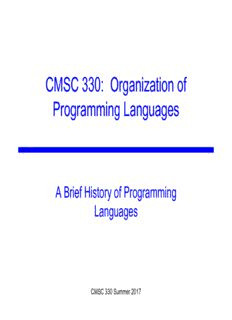
CMSC 330 PDF
Preview CMSC 330
CMSC 330: Organization of Programming Languages A Brief History of Programming Languages CMSC 330 Summer 2017 Babylon • Founded roughly 4000 years ago – Located near the Euphrates River, 56 miles south of Baghdad, Iraq • Historically influential in ancient western world • Cuneiform writing system, written on clay tablets – Some of those tablets survive to this day – Those from Hammurabi dynasty (1800-1600 BC) include mathematical calculations • (Also known for Code of Hammurabi, an early legal code) A Babylonian Algorithm A [rectangular] cistern. The height is 3, 20, and a volume of 27, 46, 40 has been excavated. The length exceeds the width by 50. You should take the reciprocal of the height, 3, 20, obtaining 18. Multiply this by the volume, 27, 46, 40, obtaining 8, 20. Take half of 50 and square it, obtaining 10, 25. Add 8, 20, and you get 8, 30, 25 The square root is 2, 55. Make two copies of this, adding [25] to the one and subtracting from the other. You find that 3, 20 [i.e., 3 1/3] is the length and 2, 30 [i.e., 2 1/2] is the width. This is the procedure. – Donald E. Knuth, Ancient Babylonian Algorithms, CACM July 1972 The number n, m represents n*(60k) + m*(60k-1) for some k More About Algorithms • Euclid’s Algorithm (Alexandria, Egypt, 300 BC) – Appeared in Elements • See http://aleph0.clarku.edu/~djoyce/elements/bookVII/propVII2.html – Computes gcd of two integers let rec gcd a b = if b = 0 then a else gcd b (a mod b) • Al-Khwarizmi (Baghdad, Iraq, 780-850 AD) – Al-Khwarizmi Concerning the Hindu Art of Reckoning – Translated into Latin (in 12th century?) • Author’s name rendered in Latin as algoritmi • Thus the word algorithm Antikythera Mechanism • Mechanical computer designed to calculate astronomical positions • Discovered in 1900-1901 – But no one knew what it was until much later! • Estimated construction in 150-100 BC http://en.wikipedia.org/wiki/File:NAMA_Machine_d%27Anticythère_1.jpg CMSC 330 Summer 2017 Charles Babbage (1791–1871) • British mathematician & mechanical engineer • Invented concept of a programmable computer – Partially built a Difference Engine A mechanical calculator for § computing polynomials Uses finite difference method § to avoid multiplication & division Never completely finished § Model built in 1991 at the § London Science Museum The Analytical Engine (1837) • Babbage described plans for an Analytical Engine – Digital, programmable using punch cards – Included branching, looping, arithmetic, and storage – Memory would store 1000 numbers w/ 500 digits each – Language similar to assembly language – Powered by steam engine • Partially constructed by 1910 – Used to compute a list of multiples of π • If built, would have been 1st Turing-complete computation device Ada Lovelace (1815-52) • British mathematician – Corresponded with Babbage from 1833 onward – In 1843, translated Italian mathematician L. Menabrea's memoir on Babbage’s proposed Analytical Engine – Appended notes on how to program the Analytical Engine to calculate Bernoulli numbers – Recognized by historians as 1st published program – Making her world’s 1st programmer • Ada programming language (1983) – Imperative, object-oriented language based on Pascal – Named in her honor Alonzo Church (1903-1995) • Mathematician at Princeton Univ. • Three key contributions: – The lambda calculus (lectures in 1936, publ. 1941) – Church’s Thesis • All effective computation is expressed by recursive (decidable) functions – Church’s Theorem • First order logic is undecidable Alan Turing (1912 - 1954) • The father of modern computer science – Dissertation work advised by Church at Princeton – Formulated the Turing machine (~1936) A general abstract computer → DFA + infinite 1D tape •Σ – A finite alphabet •Q – a set of states •s (cid:15900) Q – A start state •F ⊆ Q – The final states •δ : Q × Σ → Q × Σ × {L, R} – If δ(q, a) = (q', a', d), then if we’re in state q and see a on the tape, then replace it by a', move to state q', and move the position of the tape either left or right – A formal definition of a computable algorithm
Description: